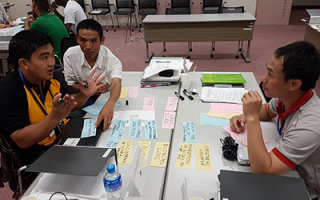이 영역에서 일본의 풍부한 경험을 바탕으로 문화 유산의 재난 위험 관리의 다양한 측면을 다룰 것입니다.
15th International Training Course on Disaster Risk Management of Cultural Heritage in Japan
Start date:
End date:
Deadline to apply:
Location:Kyoto and other Heritage Sites in Japan
Organizers
Cultural heritage is increasingly exposed to disasters caused by natural and human-induced hazards such as earthquakes, floods, fires, typhoons, terrorism, etc. Recent examples include fires in World Heritage Sites of Shuri Castle and the Notre-Dame of Paris in 2019, typhoon in Western Japan in 2018, earthquakes in Central Mexico in 2017, Kumamoto Japan, Central Italy, Myanmar in 2016, and Nepal in 2015, floods in the UK in 2015, in the Balkans in 2014, and ongoing conflicts in Iraq, Syria and Yemen. In addition, climate change is causing increase in the frequency and intensity of floods, drought, and bushfires that can create huge damage to both cultural heritage and the natural environment. These disasters not only affect immovable heritage such as monuments, archaeological sites, and historic urban areas, but also cause damage to movable heritage, including museum collections, heritage objects, religious and other artifacts that are of significance to local communities. In the aftermath of a disaster, many architectural fragments of damaged or collapsed buildings face loss or damage because of improper documentation, handling, and storage.
In recent years, fires have devastated a substantial number of heritage sites and museums. This is seen in the cases of the Notre Dame Cathedral, the Glasgow School of Arts, the Windsor Castle, part of historic cities (e.g. Valparaiso in Chile and Lijiang in China), national monuments (e.g. the Namdaemun in South Korea), religious structures (e.g. the Wangdue Phodrang in Bhutan), and tombs (e.g. the Kasubi Tombs), as well as museums such as National Museum of Brazil, Natural History in India and the Southwark Museum in the UK. Recent Forest fires in Australia have also inflicted huge damage to both natural and cultural heritage. These fires are caused by both natural and human-induced factors in cultural heritage site/museum or its surrounding. Therefore special theme for this year’s ITC will be ‘Towards the Integrated Protection of Immovable and Movable Cultural Heritage from Risk of Fire ‘
The course aims to provide interdisciplinary training on various aspects of disaster risk management of cultural heritage. Drawing upon Japan’s rich experience in this area, the course exposes the participants to specialized measures such as the establishment of a disaster risk management system, and methodologies for pre-disaster measures, disaster response, and post-disaster recovery and reconstruction.
Further details about the course and application requirements are available at
Cultural heritage is increasingly exposed to disasters caused by natural and human-induced hazards such as earthquakes, floods, fires, typhoons, terrorism, etc. Recent examples include fires in World Heritage Sites of Shuri Castle and the Notre-Dame of Paris in 2019, typhoon in Western Japan in 2018, earthquakes in Central Mexico in 2017, Kumamoto Japan, Central Italy, Myanmar in 2016, and Nepal in 2015, floods in the UK in 2015, in the Balkans in 2014, and ongoing conflicts in Iraq, Syria and Yemen. In addition, climate change is causing increase in the frequency and intensity of floods, drought, and bushfires that can create huge damage to both cultural heritage and the natural environment. These disasters not only affect immovable heritage such as monuments, archaeological sites, and historic urban areas, but also cause damage to movable heritage, including museum collections, heritage objects, religious and other artifacts that are of significance to local communities. In the aftermath of a disaster, many architectural fragments of damaged or collapsed buildings face loss or damage because of improper documentation, handling, and storage.
In recent years, fires have devastated a substantial number of heritage sites and museums. This is seen in the cases of the Notre Dame Cathedral, the Glasgow School of Arts, the Windsor Castle, part of historic cities (e.g. Valparaiso in Chile and Lijiang in China), national monuments (e.g. the Namdaemun in South Korea), religious structures (e.g. the Wangdue Phodrang in Bhutan), and tombs (e.g. the Kasubi Tombs), as well as museums such as National Museum of Brazil, Natural History in India and the Southwark Museum in the UK. Recent Forest fires in Australia have also inflicted huge damage to both natural and cultural heritage. These fires are caused by both natural and human-induced factors in cultural heritage site/museum or its surrounding. Therefore special theme for this year’s ITC will be ‘Towards the Integrated Protection of Immovable and Movable Cultural Heritage from Risk of Fire ‘
The course aims to provide interdisciplinary training on various aspects of disaster risk management of cultural heritage. Drawing upon Japan’s rich experience in this area, the course exposes the participants to specialized measures such as the establishment of a disaster risk management system, and methodologies for pre-disaster measures, disaster response, and post-disaster recovery and reconstruction.
Further details about the course and application requirements are available at

댓글 없음:
댓글 쓰기